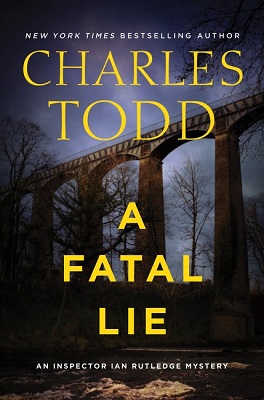Book Review
A Fatal Lie
reviewed by Barbara Saffer
Inspector Ian Rutledge of Scotland Yard returned from World War I, suffering from shell shock (PTSD) exacerbated by guilt. In addition to being traumatized by the horrors of war, Rutledge killed an insubordinate soldier in his own company. The dead man, named Hamish MacLeod, now haunts Rutledge, constantly whispering in his head – usually about criminal cases.
This addition to the long-running series opens in 1921, when Inspector Rutledge has recovered somewhat from his war experiences. Rutledge is on desk duty in London when a body is pulled from the River Dee near Llangollen, in northern Wales. The dead man apparently fell from a narrowboat aqueduct high above the river, but the corpse has no ID and the police can’t tell if the incident was an accident, suicide, or homicide. So the Welsh authorities call Scotland Yard, and Rutledge is sent to investigate.
No man is missing from Llangollen, and the body is too decomposed for easy recognition. However, the dead man’s short stature, military tattoo, and custom-made shirt lead Rutledge to identify the deceased as an Englishman named Sam Mitford, who served in a UK Bantam Battalion during the war. Rutledge drives to Mitford’s home town of Crowley, far from Llangollen, to inform Ruth Mitford about her husband’s death. Rutledge learns that the Mitfords and their relatives own a failing pub, and Sam left for Shrewsbury about a week ago, to negotiate with the pub’s liquor suppliers. Sam said nothing about going to Wales.
With ghostly Hamish providing helpful tips, Rutledge determines that Sam was pushed off the Llangollen aqueduct. However, local residents and boat owners who use the aqueduct say they never saw Sam and know nothing about his death. Determined to find out what happened, Rutledge drives back and forth between England and Wales multiple times, interviewing people and gathering evidence. Rutledge eventually learns that Sam went from town to town looking for someone, and contacted people for assistance along the way.
The case gets complicated, and comes to involve Sam’s disturbed half-sister; a devious solicitor; abandoned lead mines; murderous squatters; marital infidelity; a no snitching culture; and more. Additional murders occur, and it’s clear someone is threatened by Rutledge’s investigation. In fact Rutledge himself is imperiled when he heedlessly walks into dangerous situations.
As Rutledge travels around, we get evocative descriptions of post-WWI British towns, still reeling from the effects of war. We also learn about the Bantam Battalions. When World War I started, the height requirement for recruits to the British Army was 5′ 3″. This excluded many small men who were anxious to do their bit. So Lord Kitchener, Secretary of State for War, permitted the formation of fighting units composed of men between 4′ 10″ and 5′ 3″. These units were named Bantams after the small roosters that became their battalion emblem. The victim Sam Mitford was one of these men – brave, fearless, and determined.
This clever mystery has plot twists that will surprise even the most ardent mystery fans.
More Detectives
Advertisement







